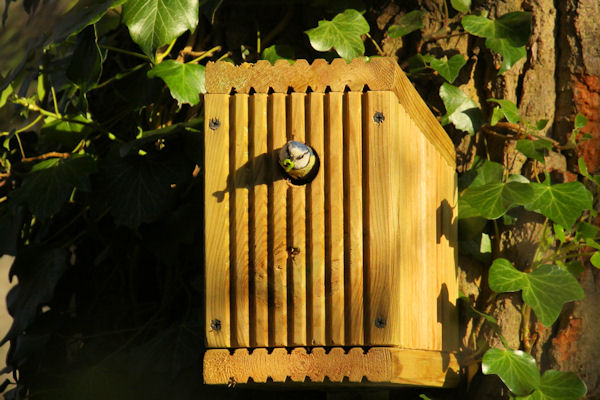Winter moth and Green Tortrix
For anyone interested in the minutiae of a Blue Tit's diet, this post looks at the relationship that the birds have with 2 species of moth.
The Winter Moth, Operophtera brumata and Green Tortrix, Tortrix viridana lay their eggs in oak trees for preference. The Winter Moth lays eggs in fissures on the bark and the Green Tortrix lays hers near the buds. The eggs hatch as the oak leaves unfurl in spring and produce bright green larvae. Some amongst us may once have called them "inchworms" to describe their style of locomotion.
The eggs are subject to the same climatic conditions as the tree and coordination between leaf opening and egg hatching is neatly choreographed. Tannin levels in the young leaves are low making them more nutritious and digestible, so the larvae grow quickly.
The canny Blue Tits will have followed the same cues of temperature and daylength to time the laying, brooding and hatching of their own eggs to coincide with the time of greatest abundance to ensure a good food supply for their chicks. From laying the first egg to hatching can take just over 3 weeks, but the birds can adjust this to hatch at the prime time. The female lays one egg a day, but doesn't start sitting until they are all laid. By managing the number of eggs laid and adjusting the start of incubation the hatch date can be brought forward or delayed by a couple of days either way.
It is fascinating to reflect on how birds can forecast the time of greatest abundance. The time of greatest need comes when the chicks are at about 9 days old. It may be that the female takes her cue from the availability of food and calcium as nesting time approaches. She cannot store the calcium needed to produce eggshell and must be in prime condition, so must have adequate supplies before laying.
Studies suggest that a Blue Tit may have to provide up to 1000 meals a day for its growing family which is a huge number over the three weeks that it takes for the chicks to fledge. Observations from a quick study in Greater Bicknor noted slightly fewer visits with around 50 per hour, but with no idea how many chicks were being fed.
(Springwatch reported a poor fledging year for the Blue Tits of UK. Spring was too late for the birds to adjust their broods adequately and in the face of this suggestion, the casual survey conducted in Greater Bicknor could indicate that the fewer visits might have been the result of foraging parents facing difficulty finding food.)
A bird that misses the optimum time for raising their chicks need not despair. As time passes, the caterpillars may be fewer due to bird predation, but they grow as they feed on the new leaves and become bigger, so maintaining the biomass available. This is also some comfort to the birds who have their nestlings taken by predators. It is still possible to make a second nesting attempt. The Great Spotted Woodpeckers have been taking their toll of the nesting boxes in Bicknor Wood and the Blue and Great Tits may have to find natural or more robust nesting sites for their second clutches.
The oak trees also play their part in the seasonal dance. Notice in Bicknor Wood that some of the trees are almost already in full leaf whilst others still look very bare. This brings a successional element to the food supply as each tree begins to leaf and the moths' eggs hatch and develop.
But the window closes once the caterpillars begin to pupate. They can be seen abseiling down from the oaks on silken threads. Once they reach the ground, they form a cocoon and pupate in the leaf-litter on the woodland floor until it is time to emerge, mate and begin the cycle again.







Comments
Post a Comment